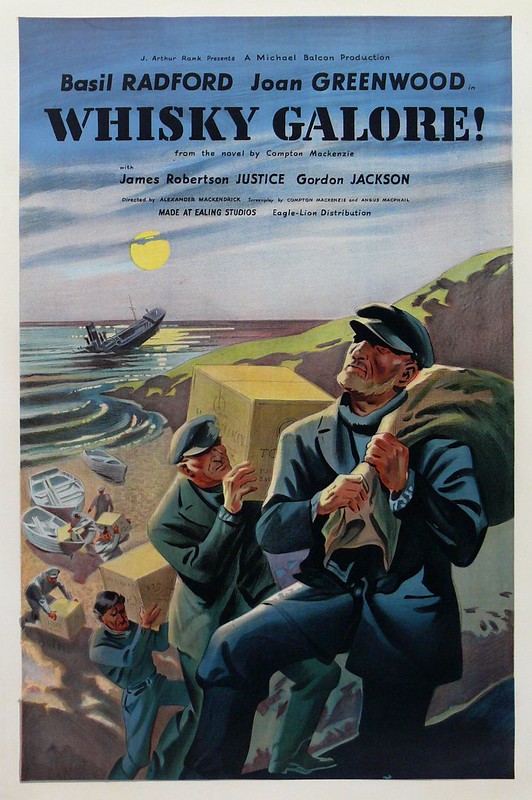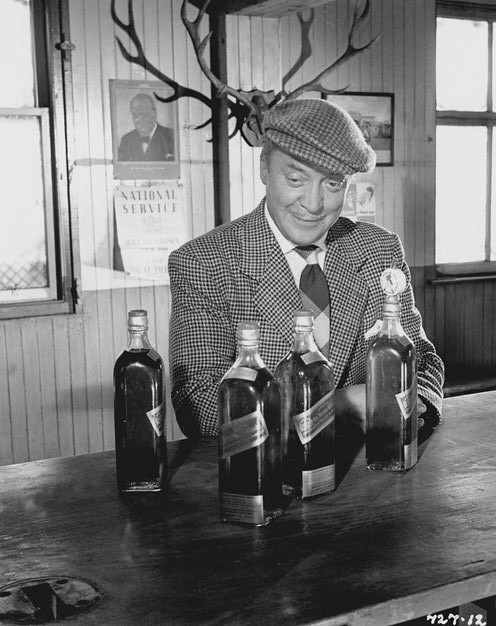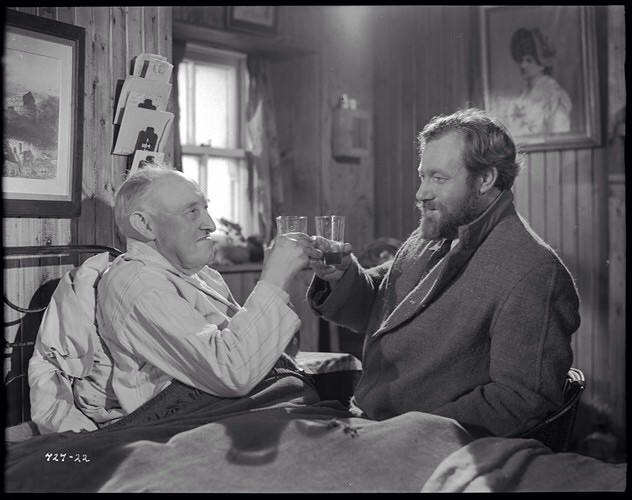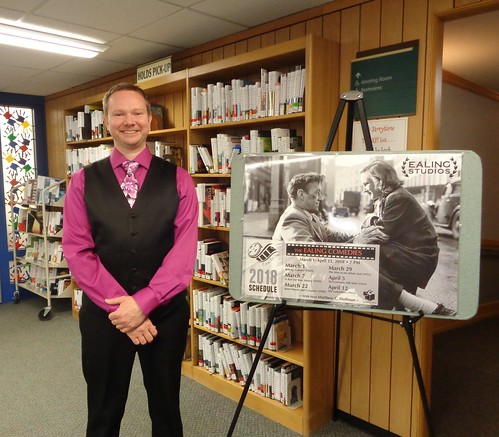Ealing Studios produced films of all genres, but in the late 1940s, their name became synonymous with comedy. Whisky Galore!, one of three important comedies that Ealing released in 1949– the others being Passport to Pimlico and Kind Hearts and Coronets— solidified Ealing’s reputation as the studio that knew how to make audiences laugh. But the humor wasn’t rooted in slapstick nor did it ever lapse into bad taste. It was a particular brand of comedy that was more whimsical and subtle, and sometimes, as we’ll see in a few weeks, quite black. Though Whisky Galore! was not the first significant comedy the studio made—historians recognize 1947’s Hue and Cry as the start of this great period—it is representative of the qualities that made the studio unique. To understand what makes an Ealing comedy, one need look no further than to Whisky Galore!.
Whisky Galore! is the story of a small Scottish community that has “gone dry.” When a freighter carrying 50,000 cases of whisky gets stranded offshore, the residents band together in the hope of rescuing the precious cargo. In their way, however, is Captain Wagggett of the Home Guard. He is determined to preserve order and keep the townspeople away from the ship. The film is based on the 1947 novel Whisky Galore, written by the English-born Scottish author Compton Mackenzie, which itself is based on a real-life incident. Mackenzie had served in the Home Guard in 1941 when he witnessed first-hand the incident of the whisky-laden SS Politician, which was wrecked off the coast of Eriskay in the Outer Hebrides, northwest of Scotland. The screenplay, which was also written by Mackenzie with Angus MacPhail, set the story in the fictional island of Todday.
How the film came to be starts with Monja Danischewsky, the Russian-born public relations man for Ealing. Danischewsky—or Danny, as he was called—had been with the studio since 1938 but had recently professed a desire to produce his own movie. He even threatened to leave the studio. Michael Balcon, the head of Ealing, knew how valuable Danischewsky was to his organization and so allowed him to be an associate producer provided he find a subject worth shooting. Danny selected the Mackenzie novel, and for his director, he chose someone who had never made a movie before. Alexander Mackendrick, who was born in Boston and later trained in graphic design, was a storyboard artist for Ealing. His lack of credits as a director, coupled with Danny’s inexperience as a producer, were major concerns for Balcon. The studio had a full slate of films lined up for production at that time, so the top talent wasn’t available to help either man. Given the relative inexperience of many of the crew, the film could have—and almost did—become a disaster.
Retreating from the confines of London, Mackendrick took the production crew on location to the island of Barra, Scotland, which became the island of Todday in the film. Whisky Galore! was populated with many locals who not only added color but assisted the cast, such as English actress Joan Greenwood, with their Scottish accents. Unfortunately, the production was stalled because of bad weather. Incessant rain ultimately forced the production to go over budget.
In The Secret Life of Ealing Studios, Robert Sellers writes, “There were also frequent clashes with Danischewsky over what the moral tone of the film should be. The Presbyterian Mackendrick held the view that the islanders were in the wrong and sided with Basil Radford’s character of the harassed Customs and Excise official, while Danny held the more majority view that the islanders should be portrayed as the charming and feckless heroes of the story.” Mackendrick said later that, “I began to realize that the most Scottish character in Whisky Galore! is Waggett the Englishman. He is the only Calvinist, puritan figure—and all the other characters aren’t Scots at all: they’re Irish!”
When the production returned to Ealing Studios, having run over schedule by several weeks, Michael Balcon was not impressed with what he saw projected in the screening room. He assumed shots were missing and thought the film could not be released in its present state. Balcon even considered cutting the running time and releasing it as a second feature. Instead, he brought in another of Ealing’s directors, Charles Crichton, to do a salvage job on the picture. Additional scenes were shot, including the montage sequence depicting the islanders hiding the whisky bottles from the customs men. Considering how well the finished film is paced and structured, we should not overlook this “assist” from the other filmmakers at Ealing. Mackendrick certainly had a strong visual sense and would go on to direct some of the studio’s best pictures including The Man in the White Suit and The Ladykillers. However, one wonders what his directorial debut might’ve looked like had Balcon not stepped in with his team.
Whisky Galore! has many of the qualities that earmark it as an Ealing film. There is a strong sense of community that binds the villagers together in a common cause. They are an underdog who face an adversary of greater influence. This, too, is reflective of Ealing’s themes that manifest in other films, particularly Passport to Pimlico, in which residents of London declare themselves to be part of French territory but are outnumbered and face a war of attrition. What is different is that the film is not about the British character or London life. Rather, we see life as it is seen through the perspective of the Scottish islanders. Mackendrick presents a people of tradition and simple ways. We see their customs through song and dance. And it is the alcohol—that wee dram of whisky– that serves not only as part of the tradition, but shapes the characters as though it were a magic elixir. “Some men are born two drinks below par,” as the doctor says. Finally, there is a realist approach to the filmmaking, particularly the opening sequence that establishes the place and imbues the film with an air of authenticity. The documentary style had always been a strong influence on Ealing production in the post-war years.
Joan Greenwood and Bruce Seton

Whisky Galore! proved to be a sleeper hit. It was nominated for the British Academy Film Award, along with Passport to Pimlico and Kind Hearts and Coronets, but they lost to Carol Reed’s The Third Man. Retitled Tight Little Island for its American release, it became the most successful Ealing film to play in this country. Embraced by the public and praised by critics, Whisky Galore! was recognized as one of the great comedies to emerge from the studio. A sequel followed in 1957 called Rockets Galore!, and in 2016, for reasons we can’t explain, a remake of the original film was released.
Nearly seventy years later, Whisky Galore! remains a lively, charming, and thoroughly entertaining film. The performances are excellent, breathing life and personality into these characters. Particularly effective is Basil Radford as Wagggett. Radford–a physical hybrid of Michael Caine and the comic character actor Eric Blore– is excellent as the pompous commander. Joan Greenwood as Peggy is equally memorable and quite luminous in the film. The husky-voiced British actress was, admittedly, one of the reasons this film was selected over the equally wonderful Passport to Pimlico, and she will appear in two other films in our series. As a side note regarding the casting, Alastair Sim, the screen’s greatest Scrooge, was offered a lead role in the film but turned it down for fear of being typecast as a Scotsman.
Though rarely screened, at least in this country, Whisky Galore! is one of the best films that Ealing ever made because it is true to life. This was why Ealing films were successful; they were universal in their appeal, and audiences didn’t have to be English—or Scottish—to appreciate what they had to say. The struggles and challenges, as well as the hopes and dreams expressed in these films, were all things we can relate to today. Though Ealing may have been modest in size, their films were far-reaching and had more to say about humanity than many of the bigger pictures that were being made elsewhere.
Addendum: We had a crowd of 64 patrons tonight (3/1/18) at the Park Ridge Public Library. It was nice to see some high school students in attendance. Our screening received one of the biggest applauses I’ve ever heard when it was over. The audience really enjoyed this film! ~MCH



